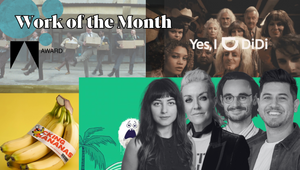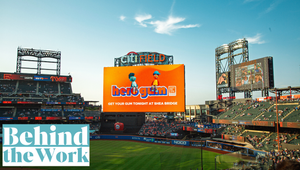
Inside the Craft of Editing for Social Media

In a society where everything moves faster than ever, attention spans are shrinking and the rise of short-form video is coming towards its peak. It is more important than ever for marketers and advertisers to have their fingers on the pulse, especially for when it comes to social media.
Leaning into this world of quick and socially forward content can be tricky at times and often the secret ingredient to the recipe for success changes within seconds.
Therein lies the question - where does craft fit into this fast paced world?
Celebrated editor Walter Murch wrote the editing student’s bible, In the Blink of an Eye, in which he breaks down editing techniques that when you see them once, you’ll never not see them again. He goes into detail surrounding the craft of the edit and power an edit has in its ability to manipulate a story. He asked the question, ‘why do cuts work?’ and suggests to the reader a set of rules that almost always pay off.
But how do all of these rules play a part in the world of social media? Is there room for them these days, or is it a case of following the latest trend? Or perhaps cutting at any given second to keep audiences on their toes?
LBB’s Casey Martin posed these questions to editors here is what they had to say:
Ned Borgman, film editor - PS260
I’ve found social media requires a different set of rules. Six seconds isn’t enough for any real narrative structure, so you simplify. Maybe it means reconceptualising the footage. You go looking for moments between takes, something that reads quickly and intuitively to the viewer. You aren’t trying to tell a story in a traditional sense - there’s no beginning, middle, or end. Instead, you focus the viewer’s attention on a single detail of the character, the scene, the conflict, and flourish. As an editor, those elemental moments are what you are always hunting for anyway, you just need to find the ones that work with little or no context.
Chad Sipkin, owner and editor, Consulate, Ltd
Perhaps the key to capturing a viewer for short form filmmaking has much to do with visualising a good idea and trying as best as possible to stick to that idea over the 6-15 seconds. As hard as that is to believe, it is possible. It is not always flashes of colour and light that are the keys to something that is stimulating. I think it is akin to an extremely well designed and riveting poster or photograph. We can be moved by the attitude, the casting, the point of view, or the balance of images (or lack thereof). I find that less can be more. Technique can be introduced, then ignored to favour a well chosen image, and then scattered back in. I find nothing more interesting than the challenge of composing these extremely short canvases. Creating a sleeve of assets and releasing them in a collection is also an exciting premise. This concept above hits most of the six essential rules of Murch: rhythm, consideration of where the eye is motivated to go, emotion, story (or suggestion of an artificial narrative)... these are well included in the success or failure of capturing attention.
Alyce Muhammad, editor, Final Cut
With shrinking attention spans in today’s time it does seem like the art of storytelling is starting to fade away as content becomes shorter and shorter to keep up. It can be quite challenging to tell a full story in fifteen seconds or less. But that’s just it. It’s a challenge. How do we tell an interesting and engaging story in less than thirty seconds?
Keeping in mind Walter Murch’s first, and arguably most important, rule of maintaining emotion or tone of the edit gives us a base for which to create. Since we don’t have the time to set up the story’s tone over a lengthy span of shots in a sequence, we have to condense the amount of shots to those that give us the most context as to how we should feel about what we are looking at. And yes, this does simplify things when it comes to story. But, there are still creative choices made through rhythm and pacing of those few shots in the edit that illustrate a complete yet short story.
Eye trace, another one of Walter Murch’s rules, is essential when it comes to social content in alternative aspect ratios like 9x16, 1x1, etc. In these smaller framing sizes, where the eye goes determines if the viewer understands what is happening in the edit. So, when creating these alternate edits choosing where the picture lands in the frame can either help push the narrative or create confusion. Many times, like in longer pieces, sound helps to provide information in the edit that we don’t see on screen. This works the same way in a shorter piece where we’re able to set the scene and move the story forward. And music of course is our tone indicator.
So long story short (pun intended), social content doesn’t have to be just moving pictures with nothing to say. Although it is challenging to make a story fit into six to fifteen seconds, it is not impossible. We can still maintain the art of storytelling no matter the length of the edit.
Megan Marie Connolly, editor, Final Cut
A short-form video must grab its audience quicker than a finger can scroll to the next piece of content. That doesn’t mean that short-form videos aren’t carefully crafted. In fact, each second can be painstakingly deliberated and mulled over. There’s an argument to say that short-form is even more carefully crafted than long form, though I am biased. Creating an engaging story is a challenge at any length, but taking days of footage and distilling that down into a 30 second spot that includes captivating imagery and showcases brand is a unique feat.
Short-form videos, some just seconds, don’t do away with Walter Murch’s basics of editing. They need storytelling, rhythm, and - perhaps most importantly - emotion, to draw in their audience. Eye trace, bi-dimensional, and tri-dimensional space are crucial to the comprehension of the content and its world, considering the limited time that the content spans. Just because something is quick - whether in duration or pace - doesn’t mean that it ignores the very principles that make a video engaging or at the very least, watchable.
I view each edit as a puzzle. I start with all the footage, all the pieces. I choose the pieces that I think will fit together the best and start to combine them. My sequences start long, but with every pass I whittle my edit down to just the best content without sacrificing story, even if it means killing some of my babies. Like long form, short-form editing is a series of decisions that we as editors make: when to cut, why to cut, where to cut to next. Whether it’s long or short form, all of these decisions ultimately combine to create an enthralling story that earns its emotional response from the viewer. In my experience, these two components are the base elements needed to seize the audience’s attention and stop them from scrolling. One shot fits here, another there, and it’s easy to see how a 30 second puzzle can have hundreds of solutions, but only a few solutions truly make a quality piece that’s worth watching.
Ryan Frey, lead editor - We Are Royale
I’ll straight up admit it – I love split-second snippets and wild fast-cut edits. I do not believe this style to be a result of shortened attention spans, but instead, we as an audience have evolved to be able to handle it. This means there are even more ways of storytelling through editorial, and the floodgates have opened. No longer are we limited to allowing everything to breathe or risk losing our audience. Ideas do not require breathing room. Ideas can still be conveyed in a flurry of edits. Let us not underestimate the speed at which our younger audience can intake visuals. Most media is now easily rewound, replayed, and rewatched many times over. Messages and storytelling are not lost in the speed of cuts as they once were in a cinema-only environment.
That being said, brutally fast cuts should only come in waves or you will exhaust everyone. They need to be used carefully and absolutely require Walter Murch’s rule of eye tracing. Each shot’s centre-of-eye focus needs to carry through to the next or your audience will be completely lost. There needs to be a method to the madness. It requires an intense amount of trial and error to get an aggressive edit to feel right, but when it does, the feeling is unmatched.
Tamer Shaaban, director, Durable Goods
We're in a world where billions of photos and videos are uploaded online every day. You're competing for attention, and your audience's attention is valuable. It's an open buffet of fast food shooting out of a firehose into their eyes and ears. For me, that means you need to create a Michelin-style burger. It's relatable, yet still well-crafted and stands out above the rest.
I've connected better with audiences by finding myself in the story first. I find an experience and character that I can get behind before I can start thinking about execution. Whether it be five minutes or 15 seconds, the story and character are the spine. How you cut it needs to be pulled from the character's state at any given point of your story. You can tell if a storyteller or filmmaker has been intentional with their work in the first few seconds of watching it. Pace, colour, sound, camera movement, and every design element you can think of needs to be carefully considered. But you need to also consider the audience you're speaking to.
An ad for Johnnie Walker, titled "Human" (2006), that lives rent-free in my head features a monologue from an Android expressing his desire to be human. Director Dante Ariola knows how and when to hold our attentionIt's cinematic and calculated,
Meanwhile, in 2013, a viral video emerged on the internet of a young woman attempting to do a handstand on a door and twerk. For weeks, the video went viral before Jimmy Kimmel revealed that he crafted the video on a soundstage, and the woman was actually a professional stunt woman. It goes to show that you don't need fast cuts and epilepsy-inducing transitions to capture an audience's attention. You just need to be intentional.
Walter Murch's rules hammer on that even further. You need to know when you cut, or if you need to cut at all. Whether you're a TikTok content creator or a working film director with a seven-figure budget, if you understand your character, story, medium, and audience, even in a sea of fast food, you can still serve the memorable Michelin Star burger.
Zeke O'Donnell, editor, BANDIT Editorial
"When editing for social media, we have to summarise the “story” of our content very quickly. Clients may realise they have even less time to grab audience attention; we might have to cut out some of that story in service of an eye-grabbing edit. One technical lookout for social is that it’s going to be compressed more. If you’re editing with a lot of cuts, it may not look as good on the platform, depending on the viewer’s internet connection.
There isn’t much difference between editing for broadcast and social media otherwise, but it is tricky when you have to edit for many things at once (i.e. both). Often we have to edit for wide-screen, but also make an edit for 9:16--portrait view, or mobile view--from the same film.
Once we get into the world of social, we’re in a world of weird, internet-y stuff. People make content all over the place, and many more people edit content who lack a traditional editing education. In some ways, the roles are changed. An editor who has been editing for a while might call these homegrown attempts a “bad edit”, but that matters less now to the average viewer. Edits are more to move a social media piece along and keep the viewer engaged. I have kids who watch a lot of YouTube, and people are making super cool things on the platform. One thing I notice on YouTube is that content can be a wall of words; people cut out every moment that doesn’t have words (i.e. all the pauses). That means there’s far less space for nuance and letting something play out, which requires a greater attention span. Content creators do anything they possibly can to keep people hooked. There is a whole swathe of best practices, like starting on a person’s face and diving right into the story during the most engaging part to avoid folks swiping away. It’s not really good for our brains, but in terms of keeping people watching, it’s really effective."
Jack LeMary, senior editor, Vagrants
Editing has always been musical to me, and yes the tempo seems to only be getting faster. Films like Requiem for a Dream inspired me early on to play with macro shots and sound design in stylistic ways, distilling actions into split second back-to-back bits that draw the viewer in rapidly.
But even with faster editing standards, I’ve never abandoned that feeling of breath between fast sequences. I think viewers still crave that break from the chaos. Video, like music, is all about the cadence of the expected vs. unexpected. If you only give people rapidfire high octane energy, they become numb to it and it fails to grab their attention any more.
Hence the rise of the anti-ad and apps like Calm, which contrast the cacophony of social media with a sudden babbling brook. As far as Mr. Murch’s take on editing, I think his rules do hold up, though the ratios have changed. Like in the infernal 6 second social ad, where rhythm accounts for at least 50% of the effectiveness. And little did he know that “best practices” would force a logo bug into the corner as an omnipresent subliminal sales tool. But for more serious pieces of art, even amidst flashy cutting techniques, emotion and story still rule. At least they do for me and anyone I care to hang out with.
Tyler Clinton, senior editor, Vagrants
With :15s becoming the new :30, we are asked to fit so much content into a blink of an eye. Walter Murch’s rule of six quickly becomes eaten up, acceptably all the way through “Rhythm”. With such a quick run time we are challenged with creating the ideal pacing. You find you just don’t have time for the “break” or “breath” that you would give it if it was a :30 or a :60. I see social as a completely different form of an ad. These race paced edits really only afford you the opportunity to feel the essence of the product, keeping brand awareness in everyone's faces and phones.
I think the saving grace of social platforms is that they’ve also allowed us to exit the broadcast world of time restraints. This opens the door for companies to hire you for 1-2min videos for their social accounts. This is where you can still find your art.















